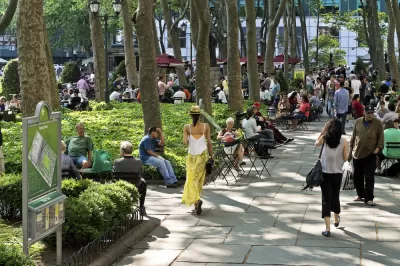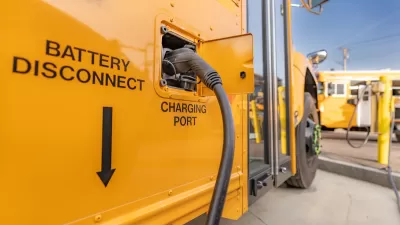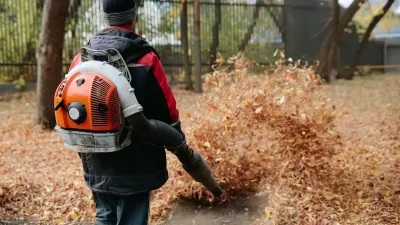Despite the stress and pollution of urban life, even the most dense, traffic-clogged cities may be as healthy as streetcar suburbs.

For the past decade or two, urbanist writers have argued that compact, walkable neighborhoods are good for you, because they encourage physical activity. But urbanists' distaste for postwar suburbia doesn’t necessarily lead to support for the kind of dense, transit-oriented urbanism I live with every day in midtown Manhattan. Some commentators argue that even though sprawl may not promote health, the most dense, urbanized places are less than ideal, because downtowns and mixed use streets are choked with cars and other sources of noise and pollution. This point of view might lead, in its most moderate form, to the conclusion that cities need a lot more greenery and park space to offset these harms.
But the fear of urban pollution might also lead to the conclusion that the least risky places are leafy, walkable streetcar suburbs like Cleveland Heights, Ohio. Cleveland Heights inhabitants can walk through low-traffic streets to low-traffic parks—but the combination of not-very-high densities and a mediocre regional transit network ensure that only 5.1 percent of commutes involve public transit. But is downtown really bad for you?
I think not, for a couple of reasons. First, some of the research that seems to support the "cities are bad for you" idea really doesn't. For example, the abstract of one study states "Asthma prevalence is generally lower in rural locations with some indication of an urban-rural gradient." A reader’s first instinct might be to say: "Oh my gosh, cities are scary! All that asthma!" But Table 2 of this study showed that asthma in the relevant large city, although higher than that of rural areas, was actually less common than in a small city with 35,000 people. Table 4 of the same study showed that asthma sufferers in the small city had more severe symptoms than those in the bigger city: more wheezing, more coughing, and more days of school missed.
It could be argued that cities must have harmful health effects because cities tend to have lower life expectancies than their suburban counterparts. But once we factor out the effects of urban poverty, this claim lacks empirical support. For example, in New York City, my Murray Hill neighborhood and the nearby Upper East Side both have a life expectancy of 85, well above that of most NYC suburbs, and even of walkable outer borough areas like Park Slope and Riverdale. And even South Bronx neighborhoods like Mott Haven and Morrisiana have life expectancies in the mid-70s, only slightly below national life expectancies. (Data can be found here [pdf].)
And in Chicago, the highest life expectancy belongs not to suburb-like areas on the city’s edge such as Edison Park (81), but to the downtown Loop and the Near North Side (both of which [pdf] have a life expectancy of 85).
In Philadelphia, most of the city has life expectancies in the low 70s, but zip code 19106 (the city’s historic district) has a life expectancy of 88, and 19103 (Center City West) has a life expectancy of 83. (Data can be found here [pdf].) By contrast, life expectancy in Chester and Montgomery Counties, the region's two most affluent suburbs, hovers around 80-81. The swankiest streetcar suburbs are closer to those of Center City: zip code 19118 (Chestnut Hill) has a life expectancy of 84.
Other studies show harmful effects that might not matter that much. For example, some studies show higher levels of mental illness in city-dwellers.* But if this was significantly harmful one might expect higher suicide rates in cities. But this does not seem to be the case. Suicide rates are consistently highest in rural counties. Where city and counties were coterminuous (allowing urban and suburban areas to be distinguished), cities generally had slightly lower suicide rates than suburban counties. In New York, Brooklyn, the Bronx and Queens had five to six suicides per 100,000 people between 2012 and 2016, while exurban Suffolk County had nine. (Most other suburban counties were somewhere between those extremes). Philadelphia’s suicide rate was higher than that of any New York-area county, but lower than that of nearby counties. The District of Columbia had 5.8 suicides per 100,000 people, while inner-suburban Montgomery County had 6.8 and suburban Fairfax and Loudoun Counties had between nine and 11. The city of San Francisco had a somewhat more mixed record: its rate (9.1 suicides per 100,000) was higher than that of San Mateo and Santa Clara Counties, but lower than that of Marin and Sonoma Counties (data here).
So if you live downtown, go to the park now and then—but if you can't make it, you still will probably live as long a life as your neighbors a few miles away.
*I note that the data on this subject is anything but conclusive; a more detailed discussion of relevant medical literature is available at pages 11-12 of this paper by Todd Litman.

Planetizen Federal Action Tracker
A weekly monitor of how Trump’s orders and actions are impacting planners and planning in America.

Maui's Vacation Rental Debate Turns Ugly
Verbal attacks, misinformation campaigns and fistfights plague a high-stakes debate to convert thousands of vacation rentals into long-term housing.

San Francisco Suspends Traffic Calming Amidst Record Deaths
Citing “a challenging fiscal landscape,” the city will cease the program on the heels of 42 traffic deaths, including 24 pedestrians.

Defunct Pittsburgh Power Plant to Become Residential Tower
A decommissioned steam heat plant will be redeveloped into almost 100 affordable housing units.

Trump Prompts Restructuring of Transportation Research Board in “Unprecedented Overreach”
The TRB has eliminated more than half of its committees including those focused on climate, equity, and cities.

Amtrak Rolls Out New Orleans to Alabama “Mardi Gras” Train
The new service will operate morning and evening departures between Mobile and New Orleans.
Urban Design for Planners 1: Software Tools
This six-course series explores essential urban design concepts using open source software and equips planners with the tools they need to participate fully in the urban design process.
Planning for Universal Design
Learn the tools for implementing Universal Design in planning regulations.
Heyer Gruel & Associates PA
JM Goldson LLC
Custer County Colorado
City of Camden Redevelopment Agency
City of Astoria
Transportation Research & Education Center (TREC) at Portland State University
Jefferson Parish Government
Camden Redevelopment Agency
City of Claremont






























